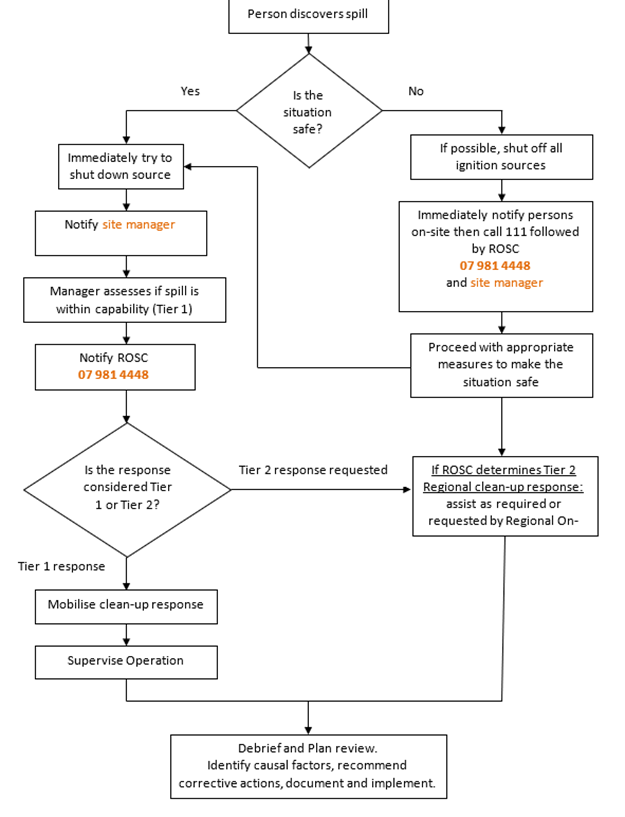Marine oil spill contingency plan (Tier 1 plans) - new application process
Important - please read first and refer to link below regarding Marine Protection Rules
Initial response to any oil spill must be oil containment and recovery by competent personnel using best practice.
Any commercial enterprise (the operator) that delivers fuel from any structure in the Coastal Marine Area (CMA) must have an Oil Transfer Site Marine Oil Spill Contingency Plan (OTSMOSCP).
This OTSMOSCP approves the transfer of oils (marine fuels) by specified operators at specific site/s listed while using equipment and procedures documented in the plan.
Plans are approved for a maximum term of 3 years.
An OTSMOSCP needs to be prepared by the operator. It is approved by Waikato Regioanl Council to authorise the transfer of oil by specified operators at specific site/s listed while using equipment and procedures documented in the plan.
It is important to understand that legislation defines ‘oil as a harmful substance for the purpose of section 224 of the Act and
(a) means petroleum in any form, including crude oil, fuel oil, sludge, oil refuse, refined products [other than petrochemical subject to the provisions of Part 140]; and
(b) includes –
(i) the substances declared to be oil in the appendix to Part 120; and
(ii) any oily mixture.’
And also understand that
‘Marine oil spill means any actual or probable release, discharge or escape of oil into the internal waters of New Zealand or New Zealand marine waters.’
OTSMOSCPs are a ‘Tier 1’ response, meaning that the incident can be immediately managed by people at the site. Waikato Regional Council must be advised of every spill no matter how small. Call (24/7) the Regional On Scene Commander at 07 981 4448.
The transfer of oil (including diesel and petrol) outside OTSMOSCP documentation parameters may result in sanction action.
Responsibilities of the OTSMOSCP holder
Any processes, information, or procedures listed in this plan must be current, accurate, easily retrieved and understood. Proof of good procedures and processes will form part of future audits. Plans must be available, current, and on-site at all times.
Allowing oil to enter the coastal marine area during operations due to careless or incompetent operation may lead to suspension of the plan, followed by possible revocation and prosecution.
An oil transfer site can only operate if there is an approved OTSMOSCP.
The operator should also ensure the structural stability of any structures used during the refuelling operation.
Note: The plan holder may not have to be the holder of the resource consent. However, the operator is required to ensure that if the use of this location as an oil transfer site requires approval under any legislation, local or territorial authority rule, plan, bylaw, or the consent of wharf or jetty owners, then that approval must be explicitly obtained.
Requirements
Documentation accompanying this plan and required on site must meet the requirements of Marine Protection Rules (see below) and will need to:
- Be clear, concise, accurate and current.
- Easily retrievable in times of emergency.
- Have an emergency contact list.
- Detail the shut off valves, pump shut down switches and response equipment.
- Detail scope of operations, equipment used, delivery methods, frequency and types of fuel transferred
- List the oil spill response equipment immediately available.
- Have refuelling procedure checklists for vessel and operator.
- Detail possible and credible spill scenarios and the relevant responses (including notification procedures).
- Describe the preventative measures undertaken to minimise the risk of an oil discharge.
- Describe Annual plan exercises, reviews and corrective actions undertaken.
- Refer to training records.
- Append MSD Sheets.
- Identify environmentally sensitive areas detailing environmental risks (e.g. wildlife).
- Be notified to the local Fire Chief .
For a more detailed overview of these requirements please refer to the 130B Schedule provided by Maritime NZ.
Contact us
You can email us to request an Oil Transfer Site Marine Oil Spill Contingency Plan template, at ROSC@waikatoregion.govt.nz
If you have any general queries please call 0800 800 401. If you are reporting an oil spill call the ROSC at 07 981 4448.


